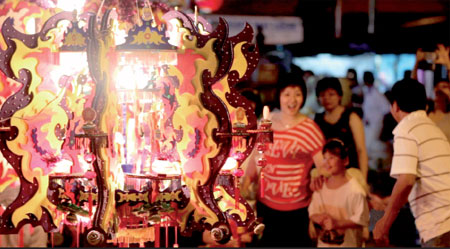
The Mid-Autumn Festival celebration plays a big role in the life of ethnic Chinese living in Singapore.
Zhou is especially impressed by the popularity of ancestral halls that dot urban and rural landscapes in Nanyang.
"These venues are not just collective homesteads of antiquity, but still have many functions. A new arrival can stay there, and get help in job hunting or even obtaining loans for a business startup. After you make it big, you can donate to the organization. Many of the big halls run schools and other nonprofit activities. In Malacca, a town with a small population, it is like a senior citizens' entertainment center, where people sip tea and sing karaoke."
Many of the customs can be traced back to the Ming Dynasty (1368-1644), but tanghao probably originated in the Song (960-1279) or even earlier Han Dynasty (206 BC-AD 220), analyzes Zhou. "It refers to your ancestral root. So, you'll see posted on some doors place names, such as Yinchuan or Dunhuang far in northern China. Young people in China have never heard of such a practice or even the name tanghao."
Not only are Zhou's documentaries richly informative, but they employ a film language that is lavish and engaging. "One of my collaborators is a graduate from film school and I share with him the notion that our work should resemble a European art film in visual style," he says.
In South of the Ocean, made for a total cost of 24 million yuan ($4 million), some of the images, including the aerial shots, are so eye-catching they would not be out of place in a big-budget feature film.
